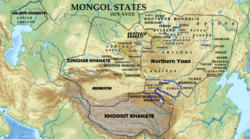Khoshut Khanate
This article includes a list of references, related reading or external links, but its sources remain unclear because it lacks inline citations. (June 2020) |
Khoshut Khanate 和碩特汗國 | |||||||||
|---|---|---|---|---|---|---|---|---|---|
| 1642–1717 | |||||||||
 Location of the Khoshut Khanate | |||||||||
| Status | Nomadic empire | ||||||||
| Religion | Tibetan Buddhism | ||||||||
| Government | Monarchy | ||||||||
| History | |||||||||
• Established | 1642 | ||||||||
• Disestablished | 1717 | ||||||||
| |||||||||
| Today part of | China | ||||||||
| History of the Mongols |
|---|
 |
|
Timeline · History · Rulers · Nobility Culture · Language · Proto-Mongols |
| History of Tibet |
|---|
 |
|
| See also |
|
|
The Khoshut Khanate was an Oirat khanate based in the Tibetan Plateau from 1642 to 1717.
Name[]
It is also referred to as Heshuote Khanate (和碩特汗國), State of Khoshut, or Quoshote Khanate. In Cyrillic it is spelled Хошууд.
History[]
Tibet was invaded by Mongols during the Yuan dynasty. In 1642, the Khoshut local government was established by Güshi Khan, a Khoshut prince and leader of the Upper Mongols. He reunified Tibet under the political and spiritual authority of the 5th Dalai Lama as leader of Tibet. With Güshi Khan as a largely uninvolved overlord, the Dalai Lama and his colleagues established a civil governmental body referred to as the Ganden Phodrang.
The Khoshut Khanate was conquered by the troops of the Dzungar Khanate in 1717, who deposed Yeshe Gyatso, a pretender to the position of the Dalai Lama promoted by Lha-bzang Khan, the last ruler of the Khoshut Khanate. The Dzungars were in turn expelled by the expedition forces of the Qing dynasty from Tibet in 1720, and Tibet was unified with Qing China. (See Qing conquest of Tibet.)
Khans of the Khoshut Khanate[]
- Güshi Khan: 1642–1655
- Dayan Khan: 1655–1668 (son)
- Tenzin Dalai Khan: 1668–1696 (son)
- Tenzin Wangchuk Khan: 1696–1697 (son)
- Lha-bzang Khan: 1697–1717 (brother)
See also[]
- Mongol conquest of Tibet
- Qing conquest of Tibet
- List of rulers of Tibet
- Tibet–Ladakh–Mughal War
References[]
- Хойт С.К. Этническая история ойратских групп. Элиста, 2015. 199 с.
- Хойт С.К. Данные фольклора для изучения путей этногенеза ойратских групп // Международная научная конференция «Сетевое востоковедение: образование, наука, культура», 7-10 декабря 2017 г.: материалы. Элиста: Изд-во Калм. ун-та, 2017. с. 286–289.
- Khoshut Khanate
- States and territories established in 1642
- States and territories disestablished in 1717
- Former countries in Chinese history
- Mongol states
- Oirats
- 1642 establishments in Asia
- Asian history stubs